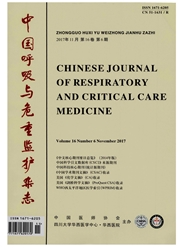

 中文摘要:
中文摘要:
目的探讨血管外肺水指数(EVLWI)和胸腔内血容积指数(ITBVI)在严重肺炎合并感染性休克患者液体管理中的指导意义。方法选择北京大学首钢医院重症医学科(ICU)2010年1月至2013年2月收治的106例严重肺炎合并感染性休克患者,采取前瞻性随机对照研究方法分为两组。EVLWI+ITBVI组54例,以脉搏指示连续心排出量(PiCCO)技术测定EVLWI和ITBVI指导液体管理;对照组52例,常规以中心静脉压(CVP)指导液体管理。比较两组患者早期目标导向性治疗(EGDT)的达标时间和达标率,治疗1d和3d的APACHEⅡ评分、SOFA评分、去甲肾上腺素用量、血清乳酸、血肌酐,72h内液体管理数据,机械通气率、机械通气时间、住ICU时间及28d病死率。结果EVLWI+ITBVI组6h的EGDT达标率比对照组高(75.9%比55.7%,P〈0.05),而EGDT达标时间和24h的EGDT达标率无显著差异(P〉0.05)。EVLwI+ITBVI组3d时APACHEⅡ评分、SOFA评分、去甲肾上腺素用量、血乳酸较1d明显下降,而对照组无显著变化;EVLWI+ITBVI组3d时血肌酐无明显增加,而对照组明显增加(P〈0.05)。EVLWI+ITBVI组0~6h液体入量和液体平衡量比对照组多,其余时段入量、出量、平衡量两组比较差异无统计学意义(P〉0.05)。EVLWI+ITBVI组机械通气率、机械通气的时间、住ICU时间和28d病死率均较对照组明显减少(P〈0.05)。结论与传统CVP指导的液体管理相比,ITBVI和EVLWI可以更精确评估和指导严重肺炎合并感染性休克患者的液体管理,减少机械通气时间和住ICU时间,降低病死率。
 英文摘要:
英文摘要:
Objective To investigate the value of extravascular lung water index (EVLWI) and intrathoracic blood volume index (ITBVI) monitoring in fluid management of severe pneumonia patients with sepsis shock. Methods A prospective controlled study was conducted in 106 patients who were diagnosed as severe pneumonia with sepsis shock in intensive care unit from January 2010 to February 2013. 54 patients who received pulse indicator continuous output (PiCCO) monitoring were enrolled into the EVLWI + ITBVI group, and EVLWI and ITBVI were used as indicator of fluid management. 52 patients who received central venous pressure (CVP) as indicator of traditional fluid management were enrolled into the control group. The time and the rate to achieve early goal-directed therapy (EGDT) target were compared between two groups. Acute physiology and chronic health evaluation II (APACHE I1 ), sepsis related organ failure assessment (SOFA) , noradrenaline dosage, serum lactic acid, serum creatinine were compared between 1 day and 3 daysafter treatment. The characteristics of fluid management were recorded and compared within 72 hours. Mechanical ventilation ratio, duration of mechanical ventilation, ICU stay and 28-day mortality were compared between two groups. Results The ratio of achieving EGDT target in 6 hours was significantly higher in the EVLWI + ITBVI group than that in the control group (75.9% vs. 55.7% ,P 〈0. 05) ,whereas the time and the ratio to achieve EGDT target in 24 hours were not statistically different. APACHE 11, SOFA, norepinephrine dosage, serum lactate were significantly decreased 3 days after treatment in the EVLWI + ITBVI group, but did not change significantly in the control group. On 3 days after treatment, serum creatinine was increased in the control group, and did not change significantly in the EVLWI + ITBVI group. The fluid intake and fluid balance volume during 0-6 hours period were significantly higher in the EVLWI + ITBVI group than those in the control grou
 同期刊论文项目
同期刊论文项目
 同项目期刊论文
同项目期刊论文
 期刊信息
期刊信息
